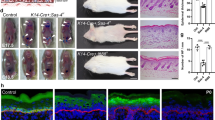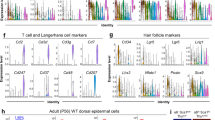Abstract
As keratinocytes move from the basal to the outer layers of a stratified squamous epithelium, they enlarge and terminally differentiate. Hence, the stage of terminal differentiation is correlated with both cell size and position. To determine whether position is an important signal in differentiation, we have now grown human keratinocytes in conditions that prevented stratification but not cell enlargement. Involucrin, a marker of terminal differentiation, was synthesized in such a monolayer, but only by large cells. We conclude that the onset of involucrin synthesis, while normally restricted to cells in a non-basal position, does not depend on this position for an essential signal; however, a signal associated with increased cell size is not ruled out. When monolayer cultures were induced to stratify, the large involucrin-containing cells preferentially adopted a suprabasal position, indicating that terminal differentiation is associated with a decrease in substrate adhesiveness. Suprabasal cell position is therefore a consequence rather than a cause of terminal differentiation.
This is a preview of subscription content, access via your institution
Access options
Subscribe to this journal
Receive 51 print issues and online access
$199.00 per year
only $3.90 per issue
Buy this article
- Purchase on Springer Link
- Instant access to full article PDF
Prices may be subject to local taxes which are calculated during checkout
Similar content being viewed by others
References
Rice, R. H. & Green, H. Cell 18, 681–694 (1979).
Banks-Schlegel, S. & Green, H. J. Cell Biol. 90, 732–737 (1981).
Watt, F. M. & Green, H. J. Cell Biol. 90, 738–742 (1981).
Hennings, H. et al. Cell 19, 245–254 (1980).
Iversen, O. H., Bjerknes, R. & Devik, F. Cell Tissue Kinet. 1, 351–367 (1968).
Steinberg, M. Proc. natn. Acad. Sci. U.S.A. 48, 1769–1776 (1962).
Moscona, A. Expl Cell Res. 22, 455–475 (1961).
Doran, T. I., Vidrich, A. & Sun, T.-T. Cell 22, 17–25 (1980).
Rheinwald, J. G. & Green, H. Cell 6, 317–330 (1975).
Green, H. Cell 15, 801–811 (1978).
Rheinwald, J. G. & Green, H. Nature 265, 421–424 (1977).
Brennan, J. K., Mansky, J., Roberts, G. & Lichtman, M. A. In Vitro 11, 354–360 (1975).
Green, H., Kehinde, O. & Thomas, J. Proc. natn. Acad. Sci. U.S.A. 76, 5665–5668 (1979).
Author information
Authors and Affiliations
Rights and permissions
About this article
Cite this article
Watt, F., Green, H. Stratification and terminal differentiation of cultured epidermal cells. Nature 295, 434–436 (1982). https://doi.org/10.1038/295434a0
Received:
Accepted:
Issue Date:
DOI: https://doi.org/10.1038/295434a0
This article is cited by
-
Human keratinocytes have two interconvertible modes of proliferation
Nature Cell Biology (2016)
-
Formation of keratinocyte multilayers on filters under airlifted or submerged culture conditions in medium containing calcium, ascorbic acid, and keratinocyte growth factor
Histochemistry and Cell Biology (2016)
-
Vimentin is necessary for colony growth of human diploid keratinocytes
Histochemistry and Cell Biology (2015)
-
Integrin-mediated adhesion and mechano-sensing in cutaneous wound healing
Cell and Tissue Research (2015)
-
Emerging interactions between skin stem cells and their niches
Nature Medicine (2014)
Comments
By submitting a comment you agree to abide by our Terms and Community Guidelines. If you find something abusive or that does not comply with our terms or guidelines please flag it as inappropriate.



